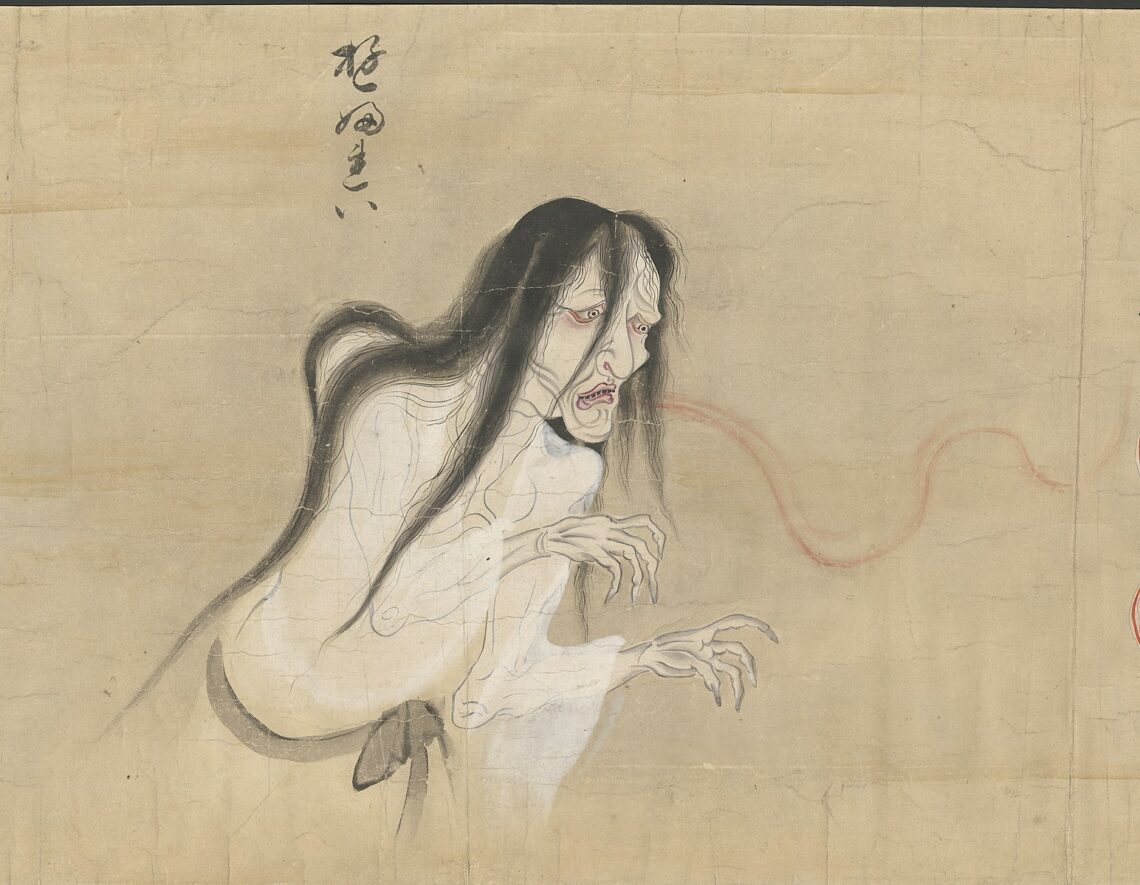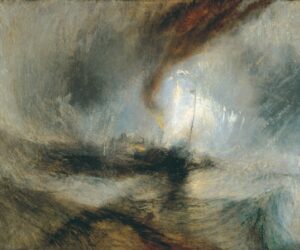
#TheadTalk Halloween: Ghostly Garb
1 – 🎃 Welcome to #ThreadTalk! It's the spookiest month & we're jumping right in with a look at ghostly garb👻!
Thrills, chills & blood-curdling horrors await as we take a trip through history & ask the question: "Okay, but what would that ghost *actually* be wearing?" 🎃

2 – We're starting in Japan. Because Japan has the best ghosts & my favorite art. Yūrei (幽霊) are closer to a Western concept of ghosts, but spirits of all kinds are common through Japanese folklore.
This one is from the incredible Bakemono no e, dating from around 1700.

3 – The Yūrei are often depicted as women with long, black hair. By the date of this print, I'd say a kosode (a kimono precursor) would be a good match.
The colors are natural, pale, haunting. You see in the embroidered closeup, too, all the sea grass & shellwork. Just wow.
4 – Tsukioka Yoshitoshi (月岡芳年) 1839-1892 was known for many prints during the Meiji period, including his 36 Ghosts.
I cannot tell you how much I love this one, The Spirit of the Komachi Cherry Tree. Perhaps not technically a "ghost" but like ::incomprehensible sounds::

5 – I can get lost in kimonos, but I was going for color here. This outer layer kimono might have been a courtesans or possibly for the stage, but the colors and composition seem about right. Dreamy, gorgeous.

6 – You can't get far without folks talking about Hamlet's father's ghost. The play was written just around 1600, stage adaptions loved dressing the cast up like this.
Which, well. Certainly historical, but for the king of the Danes? Not quite. Fuseli can't be blamed for this.

7 – If King Hamlet was a Dane, his helmet (haha Hamlet's helmet) would have looked more like this 10 C example from Norway.
He also probably had a lovely beard. The Danes were quite fastidious about their grooming, & buried their grooming kits with them in the afterlife.

8 – In Europe, it seems like everything is haunted. But you hear about the "dames blanches" (white ladies) often (and I don't mean Karens).
One such is Perchta von Rosenberg, 1429–1476, rumored to haunt Český Krumlov Castle in the Czech Republic and/or Stockholm Castle.

9 – The dames blanches are very popular in France, but they also made their way to Quebec, where my folks are. It's said Mathilde Robin haunts Montmorency Falls, where she perished after hearing her fiancé died in the 9 years war in 1759.
She even has a commemorative stamp.

10 – Reports say she wears a white wedding gown and can still be heard crying. Now a) Mathilde was probably not wearing white & b) was probably not wealthy enough to afford an expensive gown. BUT.
Maybe if she had the $$, she could have worn something like this. We can dream.

11 – Pushkin's famous ghost story, The Queen of Spades, features a most terrible main character who tries to woo the heiress of a wealthy old countess.
He threatens the countess with a gun & she dies of shock, which propels the rest of the story (which also includes her ghost).

Originally tweeted by 🦇 Natania Barron 🦇 (@NataniaBarron) on October 4, 2021.
12 – Taking a page from an earlier contemporary, I imagine that the countess might have looked a bit like Catherine the Great, circa this portrait ca 1792.
I just also like the idea of her chasing down the absolute dickhead who tried to take her fortune w/a yapping dog, too.

13 – Speaking of dogs, apparently there are some ghost dogs–along with quite a few others–on Edith Wharton's estate. The Mount in Lenox, MA, was designed with profits from her writing career.
She famously wrote: “I do not believe in ghosts, but I am afraid of them.”

14 – You can take a ghost tour of the Mount, but one of Wharton's stories, "The Lady Maid's Bell" features the ghost of a lady's maid & a country estate.
For early 1900s ghost, this striped dress is it: Simple, crisp, but still a bit eerie out of the corner of your eye.

15 – Now, away from fiction, we come to the Greenbriar Ghost. In Greenbriar County, WV, a woman named Zona (Heaster) Shue was found dead shortly after marriage, her husband saying she died of childbirth, in 1897.
But her mother claimed she saw Zona's ghost saying otherwise.

16 – It turns out the hunch, or spirit, was right.
The body was exhumed, an autopsy was performed, and lo and behold, Zona was most assuredly murdered. Shue was sentenced to life in prison.
Her mother might have worn a mourning ensemble like this.

17 – We're not quite done with books, because I never am. William Windham III was a known bookworm and British Whig statesman. In 1810, he went to help rescue books from a friend's burning library, and injured his hip doing so.
He perished a few weeks later, alas. And yet…

18 – It's said that he still inhabits Felbrigg Hall in Norfolk. Well, the library, of course. Residents claim to have seen him sitting in chairs, or hanging out at the tables. No time like the afterlife to catch up on all that reading.
He might be wearing something like this…

19 – And yes, there are ghosts in the thread. APPARENTLY. I've done over 30 of these and this is the first I've had break.
WELL. Here are some creepy pictures I came across that I just needed to share before I get to sources for tonight.
KIDS IN CALICO.
20 – Here's some more ghosty sources!
Japan:
https://en.wikipedia.org/wiki/Y%C5%ABrei
https://en.wikipedia.org/wiki/Bakemono_no_e
https://en.wikipedia.org/wiki/The_Tale_of_Genji
https://daily.jstor.org/the-surprising-history-of-the-kimono/
https://artsandculture.google.com/exhibit/the-ancient-history-making-and-wearing-a-kimono-the-kyoto-museum-of-traditional-crafts/4gKCOL4nVSotIw?hl=en
https://www.vam.ac.uk/articles/kimono
https://www.metmuseum.org/art/collection/search/53610
https://www.jstor.org/stable/j.ctt46nrwv.6?seq=1#metadata_info_tab_contents
https://commons.wikimedia.org/wiki/Category:Thirty-six_Ghosts
21 – Hamlet/Danes
https://en.wikipedia.org/wiki/Amleth
https://cdn.website-editor.net/c823ed0296224786b923c2d32a6d039c/files/uploaded/Ancient%2520danish%2520Textiles%2520from%2520bogs%2520and%2520burials_1980%2520von%2520Margrethe%2520Hald_Kap.%252005.PDF
https://en.wikipedia.org/wiki/Viking_Age_arms_and_armour#/media/File:Gjermundbu_helmet_-_cropped.jpg
https://en.natmus.dk/historical-knowledge/denmark/prehistoric-period-until-1050-ad/the-viking-age/weapons/
Mathilde –
https://wend.ca/?p=84773
22 – Queen of Spades
https://en.wikipedia.org/wiki/The_Queen_of_Spades_(story)
Edith Wharton
https://www.theparisreview.org/blog/2019/10/31/edith-whartons-ghosts/
https://teesvalleymuseums.org/blog/post/the-maids-dress-1910s/
William Windham
https://en.wikipedia.org/wiki/William_Windham
23 – I hope you enjoyed the first of my #halloween #fashionhistory #threadtalk editions! Next week we'll be checking out…
All things MOURNING! Including some debunking. Because of course.
Meanwhile, be on the lookout for ghosts, & be sure to tell me your favorite stories!

Originally tweeted by 🦇 Natania Barron 🦇 (@NataniaBarron) on October 5, 2021.









